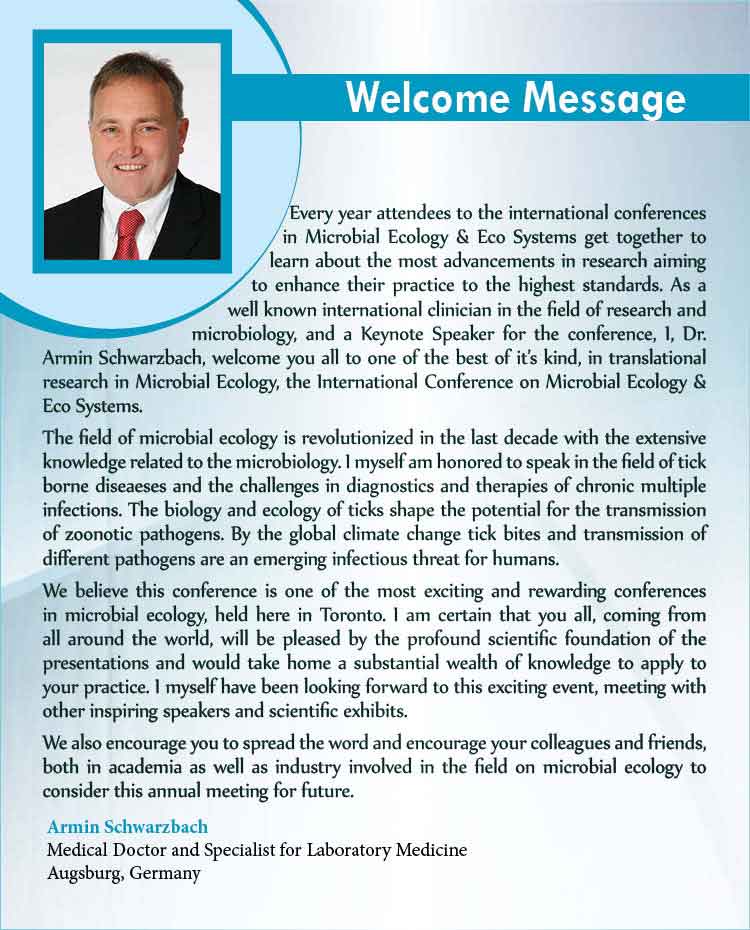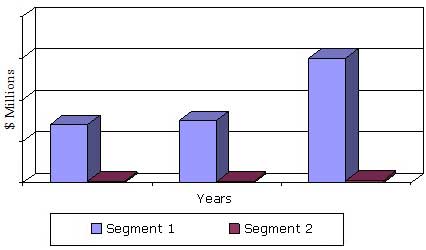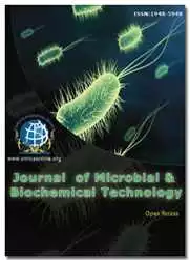Theme: New Frontiers of Invisible BioSystems
Microbial Ecology 2017


ConferenceSeries Ltd, Scientific Event Organizer and the World Class Open Access Publisher, announcing its International Conference on Microbial Ecology during September 18-20, 2017 at Toronto, Canada. Conference theme is “ New Frontiers of Invisible BioSystems”. This interesting event is managed in such a way to provide an exclusive platform for educators, new researchers, and learners to present and discuss the most recent innovations, possibilities, and concerns adopted in the field of Microbial Ecology. Microbial Ecology 2017 will comprise an informative and exciting conference program including leading keynote speakers, poster presenters, session speakers who will be presenting their research on the topics related to Microbial Ecology.
Therefore we invite you heartedly to join us at the Microbial Ecology 2017, where you will be sure to have a great experience with experts from around the world. All the important members of Microbial Ecology 2017 organizing committee look further to meet you at Toronto, Canada.
Track 1- Microbial Ecology
Microbial ecology is that the study of microbes inside the setting and their interactions with each other. Microbes are the tiniest creatures on Earth, yet despite their very little size, they have a colossal impact on North Yankee nation and on our surroundings. Microorganism, by their omnipresence, impact the entire biosphere. Microbial life plays a primary role in regulating biogeochemical systems in virtually all of our planet's environments, including some of the most extreme, from frozen environments and acidic lakes, to hydrothermal at the bottom of deepest oceans, and some of the most familiar, such as the human small intestine.
Track 2: Microbial Population & Community Ecology
Microbial population biology covers the evolution and ecology of community interactions (community ecology) between microorganisms, including microbial coevolution and predator-prey interactions. In addition, microbial population biology considers microbial interactions with more macroscopic organisms (e.g., host-parasite interactions).
Track 3: Integrated Genomics & Post-Genomics Approaches
The possibility to re-construct complete genomes of the microbial communities from the DNA extracted directly from the environment has been made possible due to the integrated genomics. Comparison of the sequenced data within and among the intra-, inter- and natural populations reveals the evolutionary processes that lead to genome diversification. Community genomic datasets also enable subsequent gene expression and proteomic studies to determine how resources are invested and functions are distributed among community members.
Track 4: Microbial Ecology & Functional Diversity of Natural Habitats
Functional diversity is a component of biodiversity that generally concerns the range of things that organisms do in communities and ecosystems. Here, we review how functional diversity can explain and predict the impact of organisms on ecosystems and thereby provide a mechanistic link between the two. Critical points in developing predictive measures of functional diversity are the choice of functional traits with which organisms are distinguished, how the diversity of that trait information is summarized into a measure of functional diversity, and that the measures of functional diversity are validated through quantitative analyses and experimental tests. There is a vast amount of trait information available for plant species and a substantial amount for animals.
Track 5: Freshwater Microbial Ecology
Fresh water is naturally occurring water on the Earth's surface in ice sheets, ice caps, glaciers, bogs, ponds, lakes, rivers, and underground as groundwater in aquifers and underground streams. Fresh water is generally characterized by having low concentrations of dissolved salts and other total dissolved solids. Freshwater habitats are divided into lentic systems, which are the still waters including ponds, lakes, swamps and mires; lotic systems, which are running water; and groundwater which flows in rocks and aquifers.
Microbes are natural and vital members of all aquatic communities, and are the foundation of lake and stream ecology—without them the natural water worlds would not be possible. Fresh-water ecosystems require energy inputs to sustain the organisms within. In lakes and streams, plants and also certain microbes conduct photosynthesis to harvest the Sun's energy. Microbial photosynthesizers include protists (known as algae) and cyanobacteria.
Track 6: Petroleum Microbiology
Petroleum Microbiology is a state-of-the-art presentation of the specific microbes that inhabit oil reservoirs, with an emphasis on the ecological significance of anaerobic microorganisms. These microorganisms, also called hydrocarbonoclastic microbe, can degrade hydrocarbons and, encompass a wide distribution of bacteria, methanogenic archaea, and some fungi. Not all hydrocarbonoclasic microbes depend on hydrocarbons to survive, but instead may use petroleum products as alternative carbon and energy sources.
Track 7: Soil Biogeochemistry and Nutrient Cycling
Soil biogeochemistry is closely related to systems ecology. As ecosystems, soils support terrestrial plant life, microbes and the other lives, including ourselves that depend on it. Soils are important sinks of carbon, playing an important role in the regulation of atmospheric carbon dioxide and climate. Soil chemical processes also are important for the regulation of nutrient and toxic element concentrations in the environment.
The nutrient cycle is nature's recycling system (movement and exchange of organic and inorganic matter back into the production of living matter). The process is controlled by food web pathways that decompose matter into mineral nutrients. Nutrient cycles occur within ecosystems. Ecosystems recycle locally, converting mineral nutrients into the production of biomass, and on a larger scale they participate in a global system of inputs and outputs where matter is exchanged and transported through a larger system of biogeochemical cycles. Mineral cycles include carbon cycle, sulfur cycle, nitrogen cycle, cycle, phosphorus, oxygen cycle, among others that continually recycle along with other mineral nutrients into productive ecological nutrition.
Track 8: Microbes in the Changing Environment
Microbes are everywhere in the biosphere, and their presence invariably affects the environment that they are growing in. The effects of microorganisms on their environment can be beneficial or harmful or unapparent with regard to human measure or observation. Beneficial microbes such as rhizobacteria and mycorrhizal fungi can help plants to ‘deal’ with pathogens and herbivorous insects as well as to tolerate abiotic stress. Therefore, beneficial microbes may play an important role in a changing environment, where abiotic and biotic stresses on plants are expected to increase.
Microbes are involved in many processes, such as the carbon and nitrogen cycles, and are responsible for both the production and consumption of greenhouse gases such as carbon dioxide and methane. Microbes could have various positive and negative feedback responses to temperature. The reason is that microbes live in very diverse communities that interact with other organisms and the environment in complex ways, which makes it difficult to make predictions about the effects of microbes on climate change.
Track 9: Impact of Microbial Ecology
Microorganisms although, are minute, their impact on our environment is immense. This impact is primarily due to their interactions with each other and with environment. The study of microbial ecology can help us in improving the human life by a thorough understanding of use of microbes in environmental restoration, food production, and bioengineering of useful products such as antibiotics, food supplements, and chemicals.
Track 10: Microbe-Host Interactions
Microbes are found everywhere. On a daily basis we ingest, inhale, and transport thousands of organisms (i.e., bacterial, viral, protozoal, or parasitic). Most have no ill effects due to protective mechanisms in our body (i.e., coughing, urinating). Humans and animals have “friendly” organisms throughout their bodies that survive as normal flora and colonize a host but do not cause disease. Microbe- Host interactions are the interactions taking place between a microbe (e.g. virus, bacteria) and their host (e.g. humans, plants). Microbe-Host interactions can be described on the population level (virus infections in a human population), on the single-cell level (individual encounters of host and bacteria), on the organismal level (e.g. virus infects host), or on the molecular level (e.g. virus protein binds to receptor on human cell).
Track 11: Geomicrobiology & Microbial Contributions to Geochemical Cycles
Geomicrobiology is the result of the combination of geology and microbiology. The field of Geomicrobiology concerns the role of microbe and microbial processes in geological and geochemical processes and vice versa. The field is especially important when dealing with microorganisms in aquifers and public drinking water supplies.
Another area of investigation in Geomicrobiology is the study of extremophile organisms, the microorganisms that thrive in environments normally considered hostile. Such environments may include extremely hot (hot springs or mid-ocean ridge black smoker) environments, extremely saline environments, or even space environments such as Martian soil or comets.
Recent observations and research in hyper-saline lagoon environments in Brazil and Australia have shown that anaerobic sulfate-reducing bacteria may be directly involved in the formation of dolomite. This suggests the alteration and replacement of limestone sediments by dolomitization in ancient rocks was possibly aided by ancestors to these anaerobic bacteria.
Some bacteria use metal ions as their energy source. They convert (or chemically reduce) the dissolved metal ions from one electrical state to another. This reduction releases energy for the bacteria's use, and, as a side product, serves to concentrate the metals into what ultimately become ore deposits. Certain iron, uranium and even gold ores are thought to have formed as the result of microbe action. Microbes are being studied and used to degrade organic and even nuclear waste pollution and assist in environmental clean-up. An application of Geomicrobiology is bioleaching, the use of microbes to extract metals from mine waste
Track 12: Aquatic Microbial Ecology
Aquatic Microbial Ecology (AME) covers all aspects of aquatic microbial dynamics, in particular viruses, prokaryotes and eukaryotes, planktonic and benthic, autotrophic and heterotophic, in marine, limnetic and brackish habitats.
Track 13: Pathogen Ecology & Evolution
The Ecology and Evolution of Infectious Diseases program supports research on the ecological, evolutionary, and socio-ecological principles and processes that influence the transmission dynamics of infectious diseases. The central theme of submitted projects must be quantitative or computational understanding of pathogen transmission dynamics. The intent is discovery of principles of infectious disease transmission and testing mathematical or computational models that elucidate infectious disease systems. Projects should be broad, interdisciplinary efforts that go beyond the scope of typical studies. They should focus on the determinants and interactions of transmission among humans, non-human animals, and/or plants. This includes, for example, the spread of pathogens; the influence of environmental factors such as climate; the population dynamics and genetics of reservoir species or hosts; the cultural, social, behavioural, and economic dimensions of disease transmission. Research may be on zoonotic, environmentally-borne, vector-borne, or enteric diseases of either terrestrial or freshwater systems or organisms, including diseases of animals and plants, at any scale from specific pathogens to inclusive environmental systems.
Track 14: Microbial Biofilms
A biofilm is group of microorganisms in which cells stick to each other and often these cells attach to a surface. These adherent cells are frequently embedded within a self-produced matrix of extracellular polymeric substance (EPS). Biofilm extracellular polymeric substance, which is also referred to as slime, is a polymeric conglomeration generally composed of extracellular DNA, proteins, and polysaccharides. Biofilms may form on living or non-living surfaces and can be prevalent in natural, industrial and hospital settings. Microbes form a biofilm in response to many factors, which may include cellular recognition of specific or non-specific attachment sites on a surface.
Track 15: Soil Microbial Ecology
Microorganisms play an essential role in maintaining soil fertility: cycling nutrients, influencing their availability; ameliorating soil structure; fortifying salubrious plant magnification; degrading organic pollutants. Some soil bacteria and fungi cause plant diseases; others are antagonistic to plant pathogens and invertebrate pests. The rhizosphere provides a region of incremented microbial activity in which certain groups of bacteria and fungi are more liable to proliferate than in the bulk soil.
Track 16: Bioremediation
Bioremediation is a waste management technique that involves the utilization of organisms to abstract or neutralize pollutants from a contaminated site. According to the Cumulated States EPA, bioremediation is a “treatment that utilizes naturally occurring organisms to break down hazardous substances into less toxic or nontoxic substances”. Technologies can be generally relegated as in situ or ex situ. In situ bioremediation involves treating the contaminated material at the site, while ex situ involves the abstraction of the contaminated material to be treated elsewhere. Some examples of bioremediation cognate technologies are phytoremediation, bioventing, bioleaching, land farming, bioreactor, composting, bio augmentation, rhizofiltration, and bio stimulation.
Track 17: Plant-microbe Interactions
The Plant-Microbe Interactions group aims to unravel at the molecular level how the plant immune system orchestrates interactions with benign microbes, pathogens and insects. This provides a rational substratum for developing sustainable strategies for disease resistance in next.
Track 18: Antimicrobials
An antimicrobial is an agent that kills microorganisms or inhibits their magnification. Antimicrobial medicines can be grouped according to the microorganisms they act primarily against. For example, antibiotics are utilized against bacteria and antifungals are utilized against fungi. They can withal be relegated according to their function. Agents that kill microbes are called microbicidal, while those that merely inhibit their magnification are called biostatic. The utilization of antimicrobial medicines to treat infection is kenned as antimicrobial chemotherapy, while the utilization of antimicrobial medicines to obviate infection is kenned as antimicrobial prophylaxis.
Track 19: Agroecology
Agroecology is the study of ecological processes applied to agricultural engenderment systems. The prefix agro- refers to agriculture. Bringing ecological principles to bear in agroecosystems can suggest novel management approaches that would not otherwise be considered. The term is often used imprecisely and may refer to "a science, a movementor a practice. Agroecologists study a variety of agroecosystems, and the field of agroecology is not associated with any one particular method of farming, whether it be organic, integrated, or conventional; intensive or extensive. Albeit it has much more mundane cerebrating and principles with some of the fore mentioned farming systems.
Track 20: Biofuel
A biofuel is a fuel that is engendered through contemporary biological processes, such as agriculture and anaerobic digestion, rather than a fuel engendered by geological processes such as those involved in the formation of fossil fuels, such as coal and petroleum, from prehistoric biological matter. Biofuels can be derived directly from plants, or indirectly from agricultural, commercial, domestic, and/or industrial wastes. Renewable biofuels generally involve contemporary carbon fixation, such as those that occur in plants or microalgae through the process of photosynthesis. Other renewable biofuels are made through the utilization or conversion of biomass. This biomass can be converted to convenient energy-containing substances in three different ways: thermal conversion, chemical conversion, and biochemical conversion. This biomass conversion can result in fuel in solid, liquid, or gas form. This incipient biomass can withal be used directly for biofuels.
ConferenceSeries Ltd takes immense pleasure & feels honoured in inviting the contributors across the globe to attend International Conference on Microbial Ecology to be held during Sept 18-20, 2017 at Toronto, Canada on the theme " New Frontiers of Invisible BioSystems " which includes prompt keynote presentations, Oral talks, Poster presentations and Exhibitions.
ConferenceSeries Ltd welcomes all the Microbiologist, Scientists, Research Scholars, Industrial professionals, Technologist and Student Delegates from Microbiology and Healthcare sectors to be a part of the esteemed Microbial Ecology- 2017. As this will be the best amalgamation of Academia and Research involving every aspect of Microbial Ecology. It is open to all types of Research methodologies both from Academia and Industry.
This year’s conference will showcase the roles of microbes in different atmosphere by relating them with revolutionary science in diverse area of microbiology through a wide range of scientific conference. The meeting is all set to be adorn by world renowned speakers. All those who are either starting your career or an old-time microbiologist can attend this conference to learn, hook-up and get galvanized. We are looking forward to welcome you all in Toronto.
Why to attend?
Microbial Ecology Conference is the indigenous knowledge which is the result of datum and experience collection of local individuals and societies in successive generations is a valuable body that should be considered for getting to sustainable development. Its success and resilience results from the profound influence that microorganisms have on life on Earth, sustaining our environment, influencing our health and driving many industrial biotechnology processes. Research areas that are marine and freshwater biogeochemical cycles and the influence of microbes on climate change through consumption and production of greenhouse gases, bioremediation of contaminated land and water, production of biofuels and use as biocatalysts, the importance of microbes in human health, interactions of microbes with animals and plants. Areas of microbiological research covered have an immense impact on the environment and mankind and thus Microbial Ecology remains a very vibrant and highly topical research field.
Why in Toronto, Canada?
Toronto is Canada's largest city, the fourth largest in North America, and home to a diverse population of about 2.8 million people. It's a global centre for business, finance, arts and culture and is consistently ranked one of the world's most livable cities. Toronto has a vibrant history of change and growth, ranging from its early occupation over 1,000 years ago to its current status as North America’s fourth largest city. Toronto is Canada's largest municipality and is made up of the former cities of Toronto, North York, Scarborough, York and Etobicoke, and the former borough of East York. The city is home to a large immigrant population, and is a national and international hub for finance, communications and cultural life. Diverse cultures, climates and landscape make Canada a destination to suit any interest. Canada is a country of immigrants and has a policy of encouraging diversity. Thus, urban hubs feature a range of ethnic neighbourhoods, restaurants, and shops. In addition to rich and varied urban centres, Canada’s natural environment is one of the most beautiful in the world. From pristine coastlines to rugged mountains and sparkling lakes, Canada’s geography inspires awe coast to coast.
The western side of Toronto is sometimes only thought of as place where industry and residences bump up against each other, but it is also a place where there are wonderful parks and waterways and where numerous pockets of small businesses and local spirit create active and diverse communities. Combining suburban enclaves and malls with condominium developments and the dense business district surrounding the North York Civic Centre, the north-central tip of Toronto is at once both relaxed and exciting. The area is also home to York University and Black Creek Pioneer Village.
Target Audience:
-
Scientists
-
Students
-
Researchers
-
Faculties
-
Environmental Microbiology institutes
-
Associations and Societies
-
Research Labs
-
Industrial delegates from Academia
-
Advertisers and Sponsors
Summary:
Microbial Ecology Conference 2017 welcomes attendees, presenters, and exhibitors from all over the world to Toronto, Canada. We are delighted to invite you all to attend and register for Microbial Ecology Conference which is going to be held during September 18 - 20, 2017 at Toronto. The organizing committee is gearing up for an exciting and informative conference program including plenary lectures, symposia, workshops on a variety of topics, poster presentations and various programs for participants from all over the world. We invite you to join us at the Microbial Ecology 2017, where you will be sure to have a meaningful experience with scholars from around the world. All members of Microbial Ecology Conference 2017 organizing committee look forward to meeting you in Toronto, Canada.
Importance and Scope:
The Conference will provide an open platform for the presentation and discussion of latest research findings on the ecology and industrial applications of microorganisms from the single cell to ecosystems level, grasping a diverse range of research areas, including the ecophysiology of microbes, molecular ecology, genomics, metagenomics and postgenomic technologies, evolutionary diversity of microbial life, the complex roles that microorganisms play in life on Earth, and the many important applications of microbes in medicine, agriculture, biotechnology and the food industry.
Why to attend?
In today's economic climate your business decisions are as crucial as ever. International Conference on Microbial Ecology allow you to maximize your time and marketing dollars while receiving immediate feedback on your new products and services. International Conference on Microbial Ecology is organizing an outstanding Scientific Exhibition/Program and anticipates the world's leading specialists involved in Microbial Ecology. Your organization will benefit with excellent exposure to the leaders in Microbial Ecology. Microbial Ecology-2017 is an exciting opportunity to showcase the new technology, the new products of your company, and/or the service your industry may offer to a broad international audience.
Target Audience:
-
Scientists
-
Students
-
Researchers
-
Faculties
-
Environmental Microbiology institutes
-
Associations and Societies
-
Research Labs
-
Industrial delegates from Academia
-
Advertisers and Sponsors
Worldwide associations:
-
International Union of Microbiological Societies
-
American Society for Microbiology
-
Society for General Microbiology
-
World Society for Microbiology
-
Society for Applied Microbiology
-
International Committee on Food Microbiology and Hygiene
-
Canadian Society of Microbiologists
-
Searches related to association of microbiology in world
-
International Society for Antiviral Research (ISAR)
-
International Society for Microbial Ecology (ISME)
-
European Molecular Biology Organization (EMBO)
-
Svenska föreningen för mikrobiologi (Swedish Society for Microbiology, SFM)
-
Swedish Society of Medical Microbiology
-
Society for General Microbiology (SGM)
Companies:
-
Antimicrobial Therapy, Inc.
-
Amplex BioSystems GmbH
-
Ani Labsystems Ltd, Oy
-
Denka Seiken Co., Ltd.
-
Curetis AG
-
Associates of Cape Cod
-
Alifax S.p.A.
-
Beckman Coulter, Inc.
-
Astellas Pharma Europe Limited
-
F. Hoffmann-La Roche Ltd. (Switzerland)
-
Abbott Laboratories, Inc. (U.S.)
Market Analysis:
The consumables, equipment and technology markets in the microbiology industry totaled nearly $7.7 billion in 2012. This total is expected to grow from $8.5 billion in 2013 to $11.4 billion in 2018, with a compound annual growth rate (CAGR) of 6.1% for the five-year period, 2013 to 2018.
-
An overview of the global microbiology market.
-
Analyses of global market trends, with data from 2012, estimates for 2013, and projections of CAGRs through 2018.
-
The U.S. commanded the largest share of 89% in the American microbiology IVD market at$1320.4 million in 2012, and is expected to reach $1715.6 million by 2017, at a CAGR of 5.6% from 2013 to 2018.
-
Europe holds the second-largest market position. Germany commanded the largest share of 20% at $223.7 million in 2013, and is expected to reach $272.5 million by 2018, at a CAGR of 4.2% from 2013 to 2018.
-
The Americas commanded the largest share of 42% in the global microbiology market at $1485.02 million in 2013, and is expected to reach $1932.8 million by 2018, at a CAGR of 5.6% from 2013 to 2018.
The global market for microbes and microbial products was valued at $143.5 billion in 2015. The market is expecting to approach nearly $306 billion in 2020 market,, with a compound annual growth rate (CAGR) of 14.6% from 2016 to 2020.
This report provides:
-
An overview of the global market for microbial products, technologies and their applications.
-
Analyses of global market trends, with data from 2015, estimates for 2016, and projections of CAGRs through 2020.
-
Identifications of microbial applications in a wide range of fields, the applications and end uses that appear to have significant commercial potential in the near to mid-term, and quantitative estimates of their current and/or future sales.
-
Examination of market drivers, regulations, and recent technological developments.
-
Information gathered from developers, vendors, and users of microbial products for commercial applications.
-
Comprehensive company profiles of major players.

Conference Highlights
- Microbial Ecology
- Microbial Population & Community Ecology
- Microbe-Host Interactions
- Integrated Genomics & Post-Genomics Approaches
- Microbial Ecology & Functional Diversity of Natural Habitats
- Geomicrobiology & Microbial Contributions to Geochemical Cycles
- Microbial Biofilms
- Freshwater Microbial Ecology
- Pathogen Ecology & Evolution
- Petroleum Microbiology
- Soil Biogeochemistry and Nutrient Cycling
- Microbes in the Changing Environment
- Impact of Microbial Ecology
- Aquatic Microbial Ecology
- Soil Microbial Ecology
- Bioremediation
- Plant-microbe Interactions
- Antimicrobials
- Agroecology
- Biofuel
- Plant Biology
To share your views and research, please click here to register for the Conference.
To Collaborate Scientific Professionals around the World
| Conference Date | September 18-20, 2017 | ||
| Sponsors & Exhibitors |
|
||
| Speaker Opportunity Closed | Day 1 | Day 2 | Day 3 |
| Poster Opportunity Closed | Click Here to View | ||
Useful Links
Special Issues
All accepted abstracts will be published in respective Our International Journals.
- Journal of Bacteriology & Parasitology
- Journal of Plant Pathology & Microbiology
- Journal of Microbial & Biochemical Technology
Abstracts will be provided with Digital Object Identifier by































